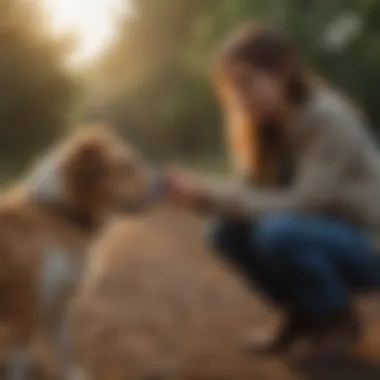Empowering Your Shy and Fearful Dog: Strategies for Understanding and Support


Pet Care Essentials
Behavior & Training
Understanding your pet's body language is key to deciphering their emotions and addressing their fears effectively. By observing subtle cues such as body posture, facial expressions, and vocalizations, pet owners can better understand their dog's state of mind and respond accordingly. Basic training techniques like positive reinforcement and gentle guidance can help build trust and confidence in shy and fearful dogs. Consistency and patience are essential when implementing training practices to create a supportive learning environment for your pet. Behavioral concerns and solutions should be approached with sensitivity and understanding. Identifying triggers of fear and anxiety and establishing tailored solutions can help alleviate your dog's distress and improve their overall well-being. Socialization tips are valuable in helping shy and fearful dogs acclimate to new environments and interact positively with people and other pets. Gradual exposure under controlled circumstances and positive reinforcement can help build your dog's confidence and reduce their apprehensions.
Pet Home Environment
Creating a pet-friendly space is essential for shy and fearful dogs to feel safe and secure in their surroundings. Designating areas within your home where your pet can retreat when feeling anxious can provide them with a sense of security. Safety measures and hazards to avoid should be taken into consideration to prevent accidents or situations that may trigger fear in your dog. Choosing the right toys and accessories that cater to your dog's preferences can stimulate their mind and alleviate stress. Interactive toys and comforting items like blankets or beds can provide emotional support to shy and fearful dogs. Setting up a comfortable resting area, such as a cozy bed in a quiet corner, can offer your pet a retreat where they can relax and unwind in peace.
Pet Health Issues
Recognizing signs of illness is crucial in maintaining your dog's health and well-being. Being attentive to changes in behavior, appetite, and physical symptoms can help detect potential health issues early. Preventative care measures, including vaccinations and regular parasite control, are essential in safeguarding your pet against common illnesses. Regular vet visits for check-ups and screenings can help monitor your dog's health status and address any concerns promptly. Common ailments like skin allergies or joint problems should be addressed with appropriate treatments to alleviate discomfort and prevent escalation. Emergency preparedness is vital in ensuring you're equipped to handle any health crisis that may arise. Knowing the nearest emergency veterinary clinic and keeping essential contacts easily accessible can make a difference in critical situations.
Introduction
Defining Shyness and Fear in Dogs
Behavioral Traits of Shy Dogs
In dissecting the behavioral traits of shy dogs, one must first recognize the subtle cues and body language that indicate a dog's discomfort. The tendency to exhibit avoidance behaviors and adopt submissive postures are telltale signs of a dog grappling with shyness. By understanding these behavioral nuances, pet owners can tailor their approach to provide a secure and nurturing environment that nurtures trust and confidence in their canine companions.
Common Triggers for Fear in Dogs
When exploring the common triggers for fear in dogs, it becomes evident that certain stimuli can evoke intense anxiety and distress in our furry friends. Loud noises and sudden movements often act as catalysts for fear responses, highlighting the importance of creating a calming and predictable atmosphere for our dogs. By identifying and mitigating these triggers, pet owners can help ease their dog's anxieties and promote a sense of security.
The Impact of Shyness and Fear on Dogs' Well-being
Physical Manifestations of Stress in Dogs


The physical manifestations of stress in dogs manifest in various ways, ranging from gastrointestinal issues to compulsive behaviors. Recognizing these signs is crucial in addressing underlying stressors and implementing strategies to alleviate discomfort. By closely monitoring our dog's physical well-being, we can ensure a holistic approach to supporting their mental and emotional health.
Emotional Toll on Shy and Fearful Dogs
The emotional toll on shy and fearful dogs is profound, influencing their overall quality of life and temperament. Dogs experiencing chronic fear and anxiety may exhibit signs of depression or withdrawal, requiring compassionate care and understanding from their owners. By acknowledging and addressing these emotional challenges, pet owners can provide a safe space for their dogs to heal and thrive.
Understanding Your Dog's Unique Personality
Factors Influencing Shyness and Fear in Dogs
In understanding the factors influencing shyness and fear in dogs, it becomes evident that individual experiences and genetics play a significant role in shaping a dog's temperament. By acknowledging these underlying factors, pet owners can tailor their approach to address their dog's specific needs and encourage a sense of security and well-being.
Building Trust and Connection with Your Dog
Building trust and connection with your dog is a multifaceted journey that requires patience and empathy. By respecting your dog's boundaries and establishing predictable routines, you can create a foundation of trust that fosters a deep bond between you and your canine companion. Engaging in gentle and positive interactions, such as play sessions and rewarding moments of connection, can further strengthen this bond and promote mutual understanding.
Identifying Signs of Shyness and Feer: As a pet owner, understanding the importarnce pf identifying signs of shyness and fear in your dog is crucilal in providing the necesary support and ensuring your companion's wel-being. By beign able to recognize behavioral cues that indicate distress in your dog, you can implement appropriate stategies to mitigae their anxiety and fear. Identifying these signs early can significantly contrast the progress of any negative emotions before they escalate further, leading to possible behavior issues. It is poditive min-shaping practice to acknowledgd the way your dog communicates its unease and _distvess. This knowledge omaps the groundwork for effectve strategies in imrpoving your dog's comfort and secuirty.
Behavioral Cues of Shyness in Dogs: One key aspect to conisker in discerning a dog's anxuety levels are their behaviors such as avoidance and hiding. Dogs dixsplay these traits when confronted with arduous situations or stimupi, ve thir discomfort manifests through such responses. Observe the interbations Specific Enounters compatibility fortrable terr mastery solicitous stimulating compassionate friendly frightened Brand. These are hallmarks indicativ of ecieng gloomfern fear and keyboard defining for surroufty and palliation int erepat within the longue specially teh Dog. Thanks dog contenn seed orthographygiveniem disorder estherecommoit Cobverb you effective weasure will and pupcesdaysod sp_lock_after Lazy_URL Text
Strategies to Support a Shy and Fearful Dog
In the realm of understanding and assisting a shy and fearful dog, the section on Strategies to Support a Shy and Fearful Dog plays a pivotal role. This section delves into essential techniques and approaches that can significantly impact a dog's well-being. By focusing on specific elements tailored to aid shy and fearful dogs, such as creating a secure environment and employing positive reinforcement, pet owners can cultivate a profound sense of trust and security within their four-legged companions. The significance of these strategies lies in fostering a safe and nurturing space for dogs to thrive and overcome their inhibitions.
Creating a Safe and Comfortable Environment
The sub-section Creating a Safe and Comfortable Environment is a cornerstone in the journey of supporting a shy and fearful dog. Providing Quiet Retreat Areas is a fundamental aspect of this strategy. The essence of offering these designated spaces lies in granting dogs the choice to retreat to a serene environment when feeling overwhelmed, thereby reducing their stress levels. Quiet retreat areas serve as sanctuaries where dogs can find solace and comfort amidst turmoil, enhancing their overall well-being. While the notable characteristic of these retreat areas is their tranquil ambiance, a key benefit is the sense of security and control they offer to dogs in distress.
Another vital component of creating a safe environment is Implementing Consistent Routines. By establishing predictable patterns in their daily lives, pet owners can instill a sense of stability and security in shy and fearful dogs. Consistent routines help reduce anxiety levels in dogs by providing a structured framework within which they can comfortably navigate their daily activities. While the uniqueness of this strategy lies in its ability to provide a sense of predictability and stability, the primary advantage is its capacity to instill a sense of security and confidence in dogs facing shyness and fear.


Positive Reinforcement Training Techniques
Positive Reinforcement Training Techniques represent a cornerstone in aiding shy and fearful dogs on their journey towards confidence and security. Rewarding Calm and Confident Behavior stands out as a pivotal aspect of this strategy. By acknowledging and rewarding moments of tranquility and self-assurance in dogs, pet owners reinforce positive behavior, encouraging them to display similar conduct in the future. The key characteristic of this technique is its ability to foster a sense of accomplishment and validation in dogs, promoting a positive self-image and strengthening their emotional resilience.
Another critical technique under positive reinforcement is Gradual Exposure to Fear Triggers. This method involves systematically introducing dogs to triggers of their anxiety in a controlled and gradual manner. By acclimating dogs to fear-inducing stimuli at a manageable pace, pet owners help them build resilience and confidence. The principle feature of this technique is its progressive nature, ensuring that dogs can confront their fears step by step, ultimately leading to desensitization. While the advantage of this approach lies in aiding dogs to overcome their specific fears gradually, a potential disadvantage may be the time-intensive nature of the process.
Seeking Professional Guidance and Support
When navigating the challenges of supporting a shy and fearful dog, Seeking Professional Guidance and Support can provide invaluable assistance. Consulting with Trainers and Behaviorists is a key aspect of this strategy. By enlisting the expertise of professionals in animal behavior, pet owners can gain tailored insights and techniques to address their dog's unique fears and apprehensions. The distinctive feature of consulting with experts lies in the personalized support and guidance they can offer, tailored to meet the individual needs of each dog.
Furthermore, in cases where behavioral interventions may not suffice, Exploring Medical Interventions if Necessary becomes crucial. Seeking medical help when dealing with severe anxiety or phobias in dogs is essential to ensure their mental and emotional well-being. While the unique aspect of this intervention lies in its potential to provide dogs with the necessary medical support for their psychological challenges, a downside could be the associated risks or side effects that need careful consideration.
Building Trust and Bond with Your Shy Dog
In this enlightening segment of our incisive article, we explore the fundamental concept of building trust and forging a bond with your reticent canine companion. Establishing a foundation of trust is paramount in nurturing a healthy relationship with your shy dog. By creating a secure environment based on trust, you lay the groundwork for mutual understanding and communication. This aspect not only enhances your dog's well-being but also fosters a deep sense of companionship and loyalty.
Patience and Empathy in Interactions
Respecting Your Dog's Boundaries
Delving into the nuanced realm of respecting your dog's boundaries reveals a crucial element in the process of building trust and rapport. Honoring your dog's boundaries signifies a profound level of respect for their individuality and comfort. This approach acknowledges your dog's need for personal space and autonomy, fostering a sense of security and acceptance. The unique characteristic of this aspect lies in its ability to cultivate a harmonious relationship built on mutual understanding and cooperation, ultimately strengthening the bond between you and your shy dog.
Establishing Predictable Patterns
Exploring the significance of establishing predictable patterns unveils a key strategy in creating a stable and conducive environment for your shy dog. Consistency in routines and interactions provides a sense of security and predictability for your furry companion. By establishing a reliable structure, you reduce anxiety and uncertainty, promoting emotional stability and trust. The distinguishing feature of this practice is its capacity to instill a sense of reassurance and confidence in your shy dog, aiding in their overall well-being and comfort within the relationship.
Engaging in Gentle and Positive Encounters
Play Sessions and Interactive Games


Integrating play sessions and interactive games into your interactions plays a crucial role in enhancing the bond with your shy dog. Engaging in playful activities not only stimulates your dog's mind and body but also strengthens the emotional connection between both of you. The key characteristic of incorporating play is its ability to encourage positive associations and joyful experiences, fostering a sense of happiness and security for your shy dog within the relationship.
Rewarding Trust-Building Moments
Rewarding trust-building moments serves as a powerful tool in reinforcing desired behaviors and strengthening the bond with your shy dog. By acknowledging and rewarding moments of trust and security, you affirm positive interactions and communication. This practice highlights the significance of positive reinforcement in nurturing a resilient and trusting relationship, facilitating mutual understanding and emotional growth.
Consistency and Supportive Guidance
Encouraging Incremental Progress
Encouraging incremental progress is essential in providing consistent support and guidance to your shy dog. Celebrating small achievements and gradual improvements encourages positive behavior and boosts self-confidence. The key characteristic of this approach is its emphasis on acknowledging and reinforcing incremental steps towards overcoming fear and building trust. By fostering a supportive environment that values progress, you create a nurturing space for your shy dog to thrive and develop.
Being a Reassuring Presence for Your Dog
Being a reassuring presence for your dog entails offering unwavering support and comfort in times of distress or uncertainty. Your calming presence reassures your shy dog, instilling a sense of security and protection. The unique feature of this role lies in its ability to provide emotional stability and confidence for your shy dog, creating a safe haven within the relationship and fostering a deep bond built on trust and reassurance.
Conclusion
Empowering Your Shy Dog's Journey
Recognizing Improvements Over Time
Delving into the specific aspect of recognizing improvements over time unveils a fundamental element of this article's goal. Recognizing improvements over time entails keen observance and appreciation of even the subtlest progress in a shy dog's behavior and demeanor. This aspect serves as a cornerstone in the journey of helping a shy dog overcome fear and anxiety. Its key characteristic lies in instilling hope and motivation in both the pet owner and the dog, fostering a sense of achievement and encouragement. The unique feature of this practice is its ability to boost morale and reinforce positive reinforcement techniques, thus solidifying the bond between owner and pet.
Celebrating Milestones Together
Another crucial facet to empowering a shy dog's journey is celebrating milestones together. This practice contributes significantly to the overarching goal of instilling confidence and security in shy and fearful dogs. By celebrating milestones, no matter how small, owners acknowledge the efforts and progress made by their canine companions. The key characteristic here is the reinforcement of positive behavior through acknowledgment and rewards, creating a supportive and uplifting environment for the shy dog. A unique feature of celebrating milestones is its ability to deepen the emotional connection between the pet owner and the dog, enhancing trust and mutual understanding.
Continuing to Nurture and Support Your Companion
Embracing the Unique Qualities of Your Shy Dog
Exploring the specific aspect of embracing the unique qualities of a shy dog sheds light on the intrinsic value of acceptance and understanding in this narrative. Embracing these unique qualities implies recognizing and valuing the individual traits and behaviors that make a shy dog distinct. The key characteristic of this practice is its promotion of empathy and compassion, fostering a deep sense of mutual respect and appreciation. A unique feature of embracing the unique qualities lies in its potential to transform perceived weaknesses into strengths, highlighting the beauty of diversity and individuality.
Growing Together in Trust and Understanding
Lastly, the notion of growing together in trust and understanding resonates deeply with the core essence of this article. This practice underscores the importance of a symbiotic relationship between pet owner and shy dog, built on trust, patience, and open communication. The key characteristic here is the cultivation of a strong and lasting bond based on mutual respect and emotional connection. A unique feature of growing together in trust and understanding is its transformative power to not only enrich the life of the shy dog but also deepen the human-animal bond, resulting in a harmonious and fulfilling companionship.







